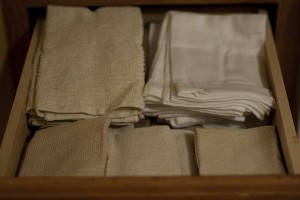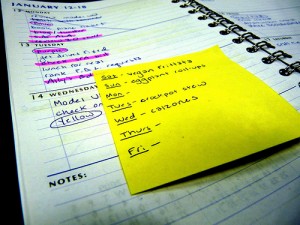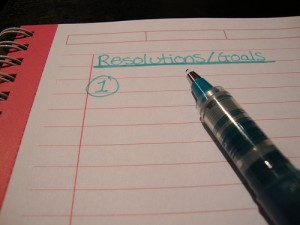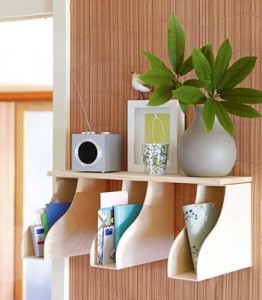 I always planned to be a stay-at-home mom for the early years of my childrens’ lives. Back when I worked 9 to 5, I remember looking forward to all the downtime I thought I’d have once we had kids. After all, if I was able to manage all of our household tasks in the evenings and weekends when I worked 40 hours a week, how much time would managing a household take when I wasn’t working full-time?
I always planned to be a stay-at-home mom for the early years of my childrens’ lives. Back when I worked 9 to 5, I remember looking forward to all the downtime I thought I’d have once we had kids. After all, if I was able to manage all of our household tasks in the evenings and weekends when I worked 40 hours a week, how much time would managing a household take when I wasn’t working full-time?
I’m sure all of you find this very funny. I know I do. Because I was so wrong.
I don’t know how such a tiny person complicates things so much, but it seems like my itty bitty 1-year-old son has tripled my housework. Or at least tripled the amount of time it takes to get things done. We have more laundry, more dishes, more things to do during the day, and less time to get them done. I have to squeeze housework in between his naps and after he’s in bed, but it can be so hard to stay on top of things when I all I want to do when he falls asleep is crash myself, or finish work I need to do, or read that book that’s been staring at me from my bedside table, or sew something.
After Judah was born, there were a few glorious weeks when I parked my butt on the couch with my baby in my arms and didn’t worry about the housework. I realize that is probably the last time my butt will be parked anywhere for a long long time. Now I’m all about getting the housework done as quickly and efficiently as possible so there’s more time to chase him and possibly a little downtime for myself when he finally goes to sleep.
Here are some of the ways I’ve simplified my long list of household chores.
Cleaning
I quickly tidy the house three times a day — once during Judah’s morning nap, once during his afternoon nap, and once after he’s in bed. This tidying takes roughly 5 minutes. I whirl through the house picking up things that are out of place, and putting them where they belong. Dishes into the sink, random dirty laundry into the hampers, paper thrown into the recycling bin or neatly stacked, shoes lined up next to the door or put away in the closet. I also sweep around Judah’s high chair as soon as I get a chance after he eats, because those crumbs drive me bonkers. This keeps me sane throughout the day, because I don’t feel constantly surrounded by clutter. Also, keeping everything relatively tidy throughout the week makes deep cleaning much less time consuming.
At least once a week, I clean the house. Usually when Tony is home either in the afternoon or on the weekend, I let him take Judah into his room for some playtime so I can get the house clean as quickly as possible. I start on one end of the house, and work my way through each room. This is when I scrub the bathrooms, clean the floors, dust, and disinfect.
Thanks to this tidy every day, clean once a week system, our house never looks like a tornado hit it. Clutter doesn’t build up, and the house looks pretty presentable throughout the week.
Laundry
I am continually amazed at how much laundry there is now that we have a toddler in the house. When Judah was a baby, I didn’t think keeping up with the laundry was so bad. But now that he’s feeding himself and getting so messy, it seems like I’m changing his clothes two or three times a day and constantly washing everything.
Because I like to check things off my to-do list instead of keeping a revolving list, I don’t do laundry every day. I prefer to wash everything once a week or so. I do all of it in one day in the winter when I’m using the dryer. In the summer, I line dry the laundry, so I usually split it up into two days so there’s enough room on the lines.
I have three hampers in the house — one in the closet in the master bedroom, one in Judah’s room, and one in the laundry room where I throw miscellaneous laundry that I pick up around the house during my daily tidying sessions. Because I tidy every day, all of the laundry is condensed to these three spots, so I don’t have to run around hunting for dirty laundry. I dump all of it out on the floor and separate it into whites, colors, towels/linens, and jeans. I put each load into one of the laundry baskets and carry them all into the laundry room. Depending on how much laundry we have, the colors and whites are sometimes double loads.
When a load is dry, I fold it as soon as I can. I hate folding and putting away laundry, so I’d rather get it done in small chunks throughout the day than sit and fold everything for an hour. I separate and stack the folded clothes by person and by drawer. Tony’s sweaters in one pile, Tony’s t-shirts in another pile, my t-shirts, Judah’s pajamas, etc. I stack them in the laundry basket in order so I’m not running back and forth putting things away. I stop in each room once, put the laundry in the proper place, and move on.
I love the feeling of folding and putting away that last load of laundry knowing that I won’t need to worry about laundry again for another week.
Dishes
I used to be a firm believer in putting a dish into the dishwasher as soon as you were finished with it. Now I’m lucky if I have time to feed myself during the day, and half the time when I put a dish into the sink, I’m holding Judah with my other arm. I still don’t like to let dishes pile too high, though. It makes the whole kitchen seem cluttered when there’s a huge pile of dishes in the sink, not to mention those stuck on messes can be a real pain to scrub out.
To stay on top of things, I wash dishes 2-3 times a day — when Judah is strapped into his high chair for his afternoon snack and after dinner — and sometimes while Tony is cooking if it’s a particularly messy meal. I wipe down the counters and the stove top every time I load the dishwasher. I am amazed at how clean the kitchen feels when I just keep the counters clean and the dishes in the sink to a minimum.
I run the dishwasher every night so the dishes are clean and ready to be put away in the morning. Sometimes if it’s a really light load, I wait and run it the next night to conserve energy and water.
Toys
Judah’s toys are the beast that I’m still struggling to find a good system to organize. His toys are scattered between two rooms — his bedroom and the guest room where we sometimes play with him when he’s bored with his bedroom. I try to keep the guest room pretty tidy. There’s a bin where we toss all of his toys when he’s not playing with them, and bigger toys just get lined up next to it. His bedroom is trickier, though. Since my tidying is almost always done when he’s sleeping, his bedroom often gets neglected. One of my big plans for early this year is to invest in some bins and organizers to keep things tidy in there, and move some of the furniture out to make the room more practical for a toddler.
Now share your ideas for keeping things simple and organized in your home. I wanna hear about your systems!








